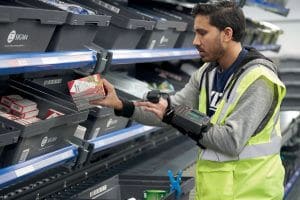Holiday shoppers are ready to spend; are you ready for them?
Once again, the holiday season is upon us. And U.S. shoppers are in a giving mood. Indeed, retail sales are expected to be stronger than last year, according to a recent forecast from the National Retail Federation (NRF). The association anticipates holiday sales during November and December 2019 to increase from 3.8 percent to 4.2 percent over the same period in 2018. That equates to a total between $727.9 billion and $730.7 billion in sales. It also represents a 3.7 percent increase in sales over the prior five years.
Further, Digital Commerce 360 found that during 2018, 60 percent of consumers planned to do more than half of their holiday shopping online, and more than 80 percent planned to spend at least a quarter of their holiday spend online. Those decisions were driven by retailers enhancing their omni-channel services — such as buy online/pickup in store — as well as robust consumer confidence numbers and an uptick in mobile shopping.

Ready, set, go!
With big holiday retail spending looming over the next few weeks, now’s a good time to evaluate whether your logistics and distribution network is ready to meet that demand. Are your fulfillment centers adequately staffed and equipped? Are all your warehousing technologies and automation systems in peak operating condition? Do your e-commerce and brick-and-mortar storefronts have the products on shoppers’ holiday lists in stock and ready for on-time delivery?
To help retailers answer those questions and to better prepare for the impending holiday peak, we’ve assembled a readiness checklist covering the key areas needed to ensure a smooth and successful season — and happy customers full of holiday cheer.
8 tips for retailers prepping for the peak holiday season
1) Plan as early as possible.
Taking a look at operational performance during previous peak holiday periods through an analysis of your key performance indicators (KPIs) is a helpful tool for determining where your operations excelled — and where they fell short. The past metrics that are most likely to impact customer satisfaction are those that measure order fulfillment speed and accuracy. For example:
- Picks completed per labor hour (or shift).
- Order accuracy per total orders shipped.
- Fulfillment cycle time from order receipt to shipment.
Software like KNAPP’s redPILOT is helping companies not only to plan and staff during peak periods, but also tracks operational performance and allows management to make real-time decisions regarding system bottlenecks. If you see a metric (or metrics) that shows an opportunity for improvement, now is the time to determine the process or equipment adjustments that need to be made before the critical holiday season kicks off.

2) Cycle count.
To ensure inventory accuracy, perform cycle counts to assess how much stock is on hand, as well as which SKUs needs replenishment before the season starts. This is also an opportunity to evaluate how quickly received inventory is added into the system and made accessible to pickers and make adjustments if necessary.
3) Focus on accuracy and quality.
While picking speed and inventory availability are both important parts of meeting customer expectations, so too is shipping the right item the first time. Mistakes in order fulfillment can upset an e-commerce customer who may turn to another retailer next time; likewise, they can result in a lost sale at the store if a promised item is not actually there.
4) Consider re-slotting.
While it takes time and physical labor, slotting — or re-locating certain SKUs into more accessible pick locations based on their picking frequency — can increase fulfillment speed for hot or seasonal items. Analyze SKU movement based on historical data, as well as work with procurement and marketing departments to anticipate accelerated movement of certain products based on specials and sales. Those products are the ones that should be re-slotted into high velocity pick zones, saving time by significantly reducing picker travel and increasing pick accuracy.
5) Cross-train and incentivize.
Many retail distribution centers rely on temporary labor during the holiday season to help handle order volumes that can rise to a peak factor of four (or more). While temps can certainly help, don’t neglect opportunities to grow your permanent staffers’ skills. By cross-training current employees on different processes in adjacent zones, your workforce will automatically become more flexible and versatile, allowing them to move to different areas to support shifting workloads. Now is not the time to introduce complex tasks, but rather keep the training simple for maximum effectiveness. Further, offer staffers financial incentives to encourage greater productivity and accuracy.
6) Engage with temporary staffing agencies.
As mentioned above, you’re probably going to need temporary labor to help permanent staff keep up with the uptick in order volumes. The sooner you can communicate with temporary staffing companies about your anticipated labor needs, the more likely they will be able to recruit and schedule resources to help mitigate any workforce shortages you experience.
7) Enhance manual processes with automation.
Consider enhancing manual processes with semi-automated solutions, such as pick- or put-to-light, put walls, or voice-directed picking. These technologies free pickers from paper-based lists and allow them to more quickly and accurately select items while boosting productivity. They also enable more advanced picking methodologies, such as batch picks in which multiples of the same item required for several different orders are picked at the same time, then separated into discrete orders at a central consolidation area.
If you are looking for significant gains, KNAPP’s family of shuttle technologies might be the answer. An all-in-shuttle system simplifies distribution operations by combining multiple functions into one solution. Picking, storage, buffering and sequencing can all be handled in the same system.

8) Schedule a system tune-up.
Even the most reliable automated system can experience downtime. Schedule preventive maintenance activities as soon as possible to safeguard that all of your equipment is in peak operating condition prior to the holidays. It’s far better to experience scheduled downtime now than unscheduled downtime when your equipment is most needed. Additionally, verify that your spare parts inventory is accurate and stocked to maximize uptime should a failure occur. Also, consider the addition of a temporary on-site technician, or a short-term contract with the original equipment manufacturer for enhanced support services during this critical season. Get in touch with our customer service team for more detailed information.

Looking for more insights into different approaches for handling peak holiday volumes? Please write to us at blog@knapp.com.
Further reading recommendations

In what ways can robotics and AI be used in retail logistics? How can robots help on Black Friday? How do robots take the pressure off humans in the warehouse?

Different structures mean that the “last mile” – in other words, the journey the package takes from the warehouse to the customer – is different for each online retailer.

The peak time of retail sales has a rocket start with Black Friday at the end of November every year, opening the Christmas shopping season. Over half of all British consumers will make purchases on Black Friday, and of these, almost 80 % will do so online.
